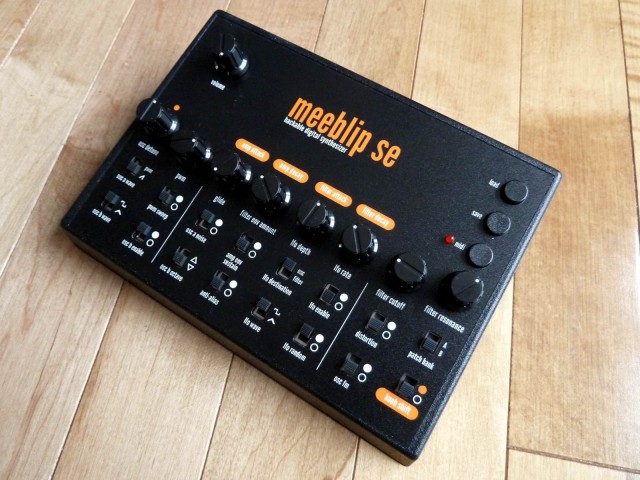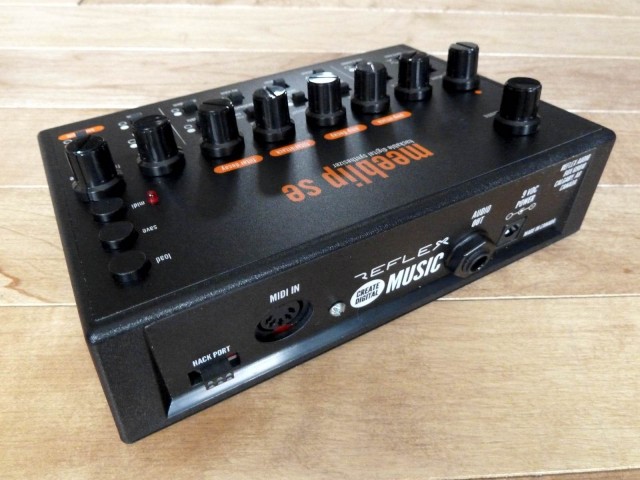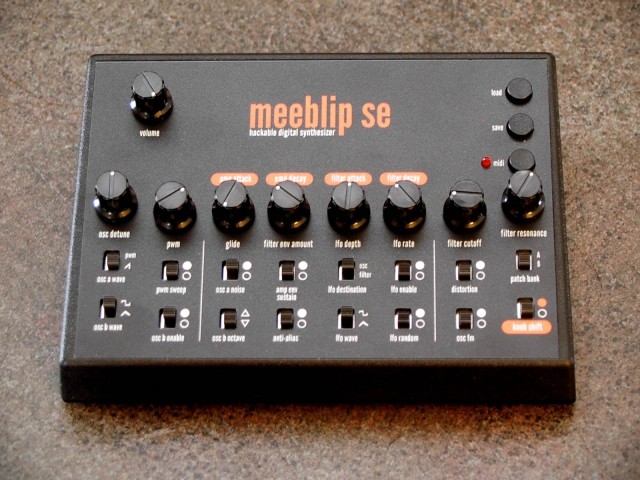
MeeBlip SE’s new limited edition features retro color scheme and knobs, plus 30 patch memores – and now ships fully-assembled to most of the world.
“Open source hardware” has generally come to mean something for hobbyists, something involving soldering irons and code. MeeBlip is about something different: it’s about making a musical instrument anyone can play, right away – with or without soldering. It’s about making music. And that’s why I’ve been glad to have CDM involved in this project: we get to build something that embodies what we believe in.
Now, you can get a Limited Edition, retro-styled MeeBlip SE for US$149.95 / €149.95 (incl VAT) / £119.95 (incl VAT), shipped just about anywhere worldwide, fully-assembled.
Order page | International info | SE Limited Edition info
The new version includes a vintage-inspired black-and-orange paint scheme and knobs, expanded 30-patch memory for quickly accessing your own sounds, and all the MIDI connectivity and sonic versatility that has made the synth a hit, plus bundled power if you buy in the USA, Canada, UK, or Europe. Under the hood, it’s still open source – every circuit, every line of code is on GitHub. You can learn from that, modify it – or just enjoy the synth knowing it’s there. Let’s back up and talk about what MeeBlip means in December 2012 – and hear what kinds of music it can make.
MeeBlip SE Fall 2012 Limited Edition: Where We’re At
Two years ago, CDM joined with engineer James Grahame to release the MeeBlip. Two years of making this hardware has posed some significant challenges. But if we’ve fought through it, it’s because we wanted to demonstrate that you could get a fully-playable, affordable, ready-to-use, open-source synth — by actually shipping it. And we wanted to do that because this was the kind of hardware we wanted ourselves.
2012’s MeeBlip SE tells that story better than anything we’ve made so far. It’s now fully-assembled, so you can start playing right away – or give it as a gift to someone as their first synth. (It comes with a printed guide on how to use it in the box, too.) Two years of development, all open source – with feedback from our community – means that it sounds better and works more reliably, too. This is the SE-edition synth that won the Key Buy award from Keyboard Magazine, as far as I know the first open source product to do so.
We’re also much smarter about shipping internationally. In North America, we’re using fulfillment by Amazon and shipping direct from Canada. In Europe, we’re shipping via DHL from Berlin. If you buy this week in North America or Europe, you’ll get MeeBlip in time for Christmas.
We include power, too; European customers now get a custom power adapter with swappable Europlug and UK adapters right in the box, in addition to our standard bundled North American adapter for the USA and Canada. (Elsewhere in the world, we keep shipping costs low by letting you buy the appropriate adapter for where you live.)
This stuff matters, because we want to make sure that details of shipping or power or assembly don’t get between you and making music. But let’s talk about music.

MeeBlip has onboard MIDI input for connecting keyboards, sequencers, and computers. For those who do want to modify it, you can connect a programmer or Arduino to the “hack port.” Or just use it as-is.
Hands-on control, MIDI
MeeBlip is designed to give you physical control over sound – no menus or screens required. While that means reducing functions to a set of knobs and switches, make no mistake: you can get a lot of sounds out of this synth, and you can always find those sounds just by using your fingers. And because MeeBlip has a standard MIDI DIN port, it’s easy for anyone to use and play. You can “upcycle” an old garage sale keyboard find or connect a $50 Rock Band keytar or use a $30 USB MIDI adapter to connect to a computer.
Once you plug it in, you can make all sorts of music. Making synths is, generally speaking, a terrible way to make money, so you’d better do it because you love what happens when you share what you’ve created with other musicians. And our community has made some amazing things – you’re the reason we keep on doing this.
Listen to the results
For a sampling, here are three radically different directions you can go with MeeBlip sounds, and a few of my favorite MeeBlip-made creations from our users that – so far – haven’t been heard yet on CDM. (See the ongoing audio demo thread MeeBlippers have made for a lot more!)
MeeBlip: The chip music game soundtrack synth
MeeBlip’s digital design is inspired in part by classics like the SID found in the Commodore 64. It’s still a 16-bit synth, and can sound analog if you like – but you can also go raw and digital and make chip music. It really comes down to the user and composer.
“Squid Racing” by MEGA SYNTH (Darren M. Mittermeier) blew us away. I wish someone would make a game around this soundtrack. Listen:
As featured on meeblip.com: MeeBlip-Made Music: Squid Racing, a Funky, Chippy Tune
MeeBlip: The experimental/ambient synth
UEM, aka Los Angeles-based William Harrington, offers this beautiful, cinematic track called “On the Edge.” Pushed to its limits, MeeBlip’s digital filter and oscillators are capable of a sound all their own.
As featured on meeblip.com: MeeBlip-Made Music: On the Edge, Beautifully Contemplative Ambient Track
MeeBlip: The bassline-generating, low end, dance-making synth
Making dance music with MeeBlip is a lot of fun. You can’t hear it online, but this thing can create floor-shaking bass. (The fact that it’s small and inexpensive makes that more fun.) Here are a few examples:
renderful (New Orleans-based Codey Christensen) uses a monotron filter alongside the MeeBlip for an acid creation:
celeriak (Adelaide, Australia-based Joe Bradden) creates a freestyled track, using all MeeBlip SE sounds (seriously) apart from drums:
Get yours now
The point of MeeBlip for us was shipping. When we’re not doing that, we’re really unhappy. When we are, we’re ecstatic. Here’s how to get yours.
Order page | International info | SE Limited Edition info
Got questions about all of this? I’m happy to answer them on comments, so fire away.
